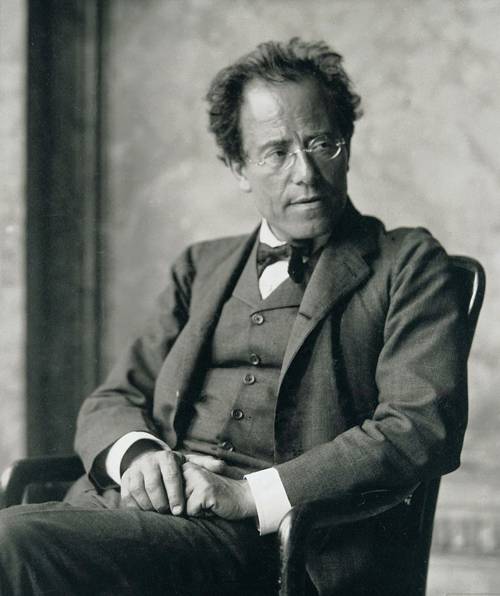
FAQ About Gustav Mahler

Who was Gustav Mahler?
Gustav Mahler was an Austrian composer and conductor, born on July 7, 1860, and died on May 18, 1911. He is widely recognized for his large-scale symphonies and song cycles that incorporate the complexities of the human experience, blending traditional Austro-Germanic music with broader influences.

What is Gustav Mahler famous for?
Gustav Mahler is most famous for his symphonies and song cycles. His works are characterized by their rich emotional depth and often massive orchestration. He played a significant role in bridging the 19th-century Austro-Germanic tradition with 20th-century modernism in classical music.

How many symphonies did Gustav Mahler compose?
Gustav Mahler composed a total of ten symphonies. The tenth symphony was not completed by him but later reconstructed. These works are notable for their expansive forms and profound emotional and philosophical content.

Which of Mahler's symphonies is the most famous?
One of Gustav Mahler's most famous symphonies is his Symphony No. 5, which includes the well-loved "Adagietto" movement. Another highly acclaimed work is his Symphony No. 2, also known as the "Resurrection" Symphony.

What themes did Mahler often explore in his music?
Gustav Mahler often explored themes of life, death, nature, spirituality, and the human condition. His compositions reflect a deep philosophical inquiry into existence and often express contrasts such as joy and sorrow, beauty and terror.

What impact did Mahler have on classical music?
Gustav Mahler had a profound impact on classical music by expanding the scope and scale of the symphony and exploring new depths of emotional expression. His work influenced later composers like Arnold Schoenberg, Dmitri Shostakovich, and Benjamin Britten.

Was Mahler appreciated during his lifetime?
During his lifetime, Gustav Mahler was better known as a conductor than as a composer. His compositions were often met with mixed reviews, partly due to their complex and innovative nature. Over time, however, his reputation as a composer grew, and he is now regarded as one of the great symphonic composers of the late Romantic period.

Did Mahler only compose symphonies?
In addition to his symphonies, Gustav Mahler composed a number of song cycles, which are integral parts of his oeuvre. Some of his notable song cycles include "Lieder eines fahrenden Gesellen" (Songs of a Wayfarer) and "Kindertotenlieder" (Songs on the Death of Children).

What challenges did Mahler face in his career?
Gustav Mahler faced numerous challenges in his career, including anti-Semitism, which affected his positions and public reception. Additionally, his innovative and complex compositions were often misunderstood or criticized during his lifetime.

Where did Gustav Mahler conduct?
Gustav Mahler held numerous prestigious conducting positions during his career, including the Vienna Court Opera, the Metropolitan Opera in New York, and the New York Philharmonic. He was highly respected for his interpretations and innovations in conducting.

Was Mahler's music influenced by his personal life?
Yes, Mahler's music was deeply influenced by his personal experiences and emotions. His complex emotional world, shaped by personal tragedies such as the death of his siblings and his own health struggles, is reflected in the poignant and expressive nature of his compositions.

What innovations did Mahler bring to the symphony?
Gustav Mahler introduced several innovations in his symphonic work, including the expansion of the orchestra, the incorporation of song and human voice, and the use of unconventional structures and themes. His symphonies often require large orchestras and explore profound and diverse emotional landscapes.

Did Mahler have any students or direct successors?
Mahler did not have many direct students, but his innovative techniques and ideas influenced many later composers. Arnold Schoenberg, who knew Mahler personally, regarded him as a significant precursor to the Second Viennese School, and other composers like Alban Berg and Schoenberg himself were inspired by Mahler's work.

How is Mahler's influence seen in modern music?
Mahler's influence is evident in the works of later composers who adopted his innovative approaches to orchestration and form. His emotional expressiveness and structural experimentation can be seen in the music of 20th-century composers like Dmitri Shostakovich and Benjamin Britten.

Did Mahler write any operas?
No, Gustav Mahler did not compose any operas. While his conducting career involved significant opera work, his compositional focus remained on symphonies and song cycles.

What are some notable recordings of Mahler's work?
There are numerous acclaimed recordings of Mahler's works. Notable conductors who have made significant recordings include Leonard Bernstein, Claudio Abbado, and Bernard Haitink. Each brings their own interpretation to Mahler's complex emotional landscapes.

How did Mahler's music evolve throughout his career?
Mahler's music evolved from the youthful energy and folk influences in his early works to the profound spiritual and philosophical exploration of his later symphonies. Over time, his compositions grew more complex and introspective, often reflecting his personal struggles and insights into human existence.

In which musical period did Mahler compose?
Gustav Mahler composed during the late Romantic period. His work is often viewed as a bridge between 19th-century Romanticism and 20th-century modernism, incorporating both traditional and innovative elements.

Why is Mahler's "Adagietto" so popular?
The "Adagietto" from Mahler's Symphony No. 5 is particularly popular due to its hauntingly beautiful melody and profound emotional depth. It has been widely used in films and cultural contexts, enhancing its recognition and appreciation.

How did Mahler's Symphony No. 1 differ from his later symphonies?
Mahler's Symphony No. 1, often called the "Titan," is distinctive for its use of folk elements and vibrant orchestration. Compared to his later works, it is generally more straightforward, but it already displays the expansive structure and emotional range that would characterize his later symphonies.
